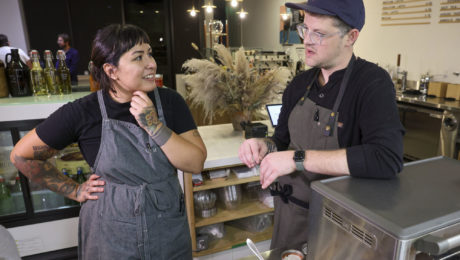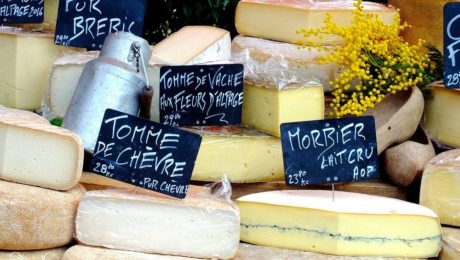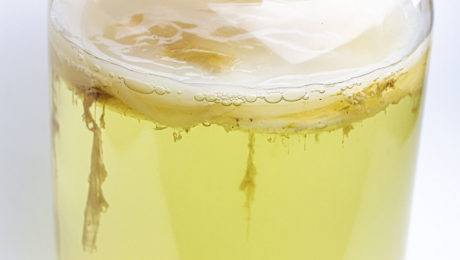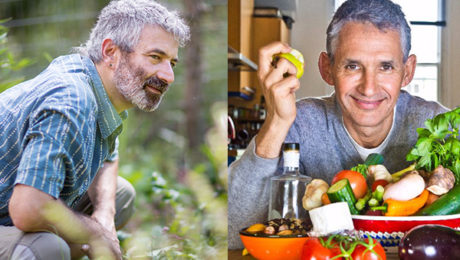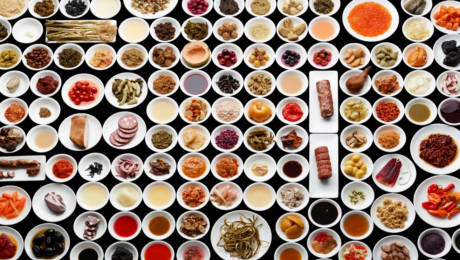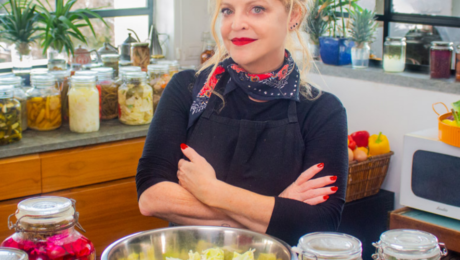Fermentation Tops New Year Lists
When The Fermentation Association began tracking industry news five years ago, we put a write-up in our newsletter when fermentation made a food publication’s new year “trend” or “best of” list. Today, as we analyze the 2023 lists, we’re finding it too overwhelming to write a story for each new trend list. Fermentation is dominating 2023.
End-of-year lists often define which foods Americans will be obsessed with in the New Year. Umami-packed fermentation is also at the center of multiple larger trends. Today’s diners are looking for foods that are functional, intensely flavored, international, sustainable, aid gut health and combine sweet and savory.
Christopher Koetke, a global culinary expert and executive chef at Ajinomoto in Chicago, says he thinks there will “be even more of an explosion of fermented products,” reads an article in the Medium.
“As consumers continue to seek out new global flavor profiles, I anticipate 2023 will be the year that umami finally takes center stage,” Koetke says. “I expect to see umami not only in sauces, snack foods, and sandwiches, but branching out into more unexpected uses like desserts and cocktails.”
Interestingly, many of these food publications pointed to McCormick releasing a Miso Caramel Seasoning as evidence fermentation is propelling into the zeitgeist.
Here’s a roundup of fermentation highlights:
“Here is another trend that’s been brewing (fermenting?) for some time. While fermented foods are certainly nothing new, their trendiness has been sneaking in and taking hold of us with things like kimchi and kombucha for the past few years. In 2023, we’re anticipating a bag wave of fermented foods will hit the shelves. This trend ties in deliciously with the “sweets plus” prediction, as many traditionally sweet flavors are expected to fuse with fermented flavors. We’ve begun to see this unusually tasty combination already in products like McCormick’s miso caramel seasoning, which launched just this year.”
- The Manual, “Food Trends That Are About To Take Over 2023”
There’s no doubt that fermented foods like kimchi, kombucha, and tempeh have increased in popularity and what’s not to love about these foods?
They’re a mix of umami and sour flavors that are produced from natural fermentation — this just means they’re made by microorganisms — which yields complex, full flavors.
To get ahead of the trend, McCormick Foods, arguably one of the largest spice companies, has already launched a new blend named Miso Caramel Seasoning. You can even find a recipe for Miso Caramel Oatmeal Whoopie Pies on their website.
It’s possible that Covid-19 has helped boost fermented foods to its top position since these products often contain probiotics which can aid in digestive health, immunity, and overall wellness. Topics that have been on everyone’s mind in recent years amid a global pandemic.
- The Medium, “Flavor scientists predict the biggest trends in foods for 2023”
“I’m going with fermented and the sour and umami flavors produced from it,” says Jan Matsuno, founder of Yumbini Foods and Mindful Food Consulting, when asked to peer into her crystal ball to predict a flavor trend set to make the biggest impact in the coming year. “Think kimchi, miso, beet kvass, pickles, beer, and kombucha.”
This ties in closely to the Sweet Plus trend, playing off the popularity of more complex flavors that often result from the fermentation process. In addition, as Matsuno points out, “fermented ties in squarely with Korean, the hottest ethnic cuisine around, and its use of tangy, spicy fermented vegetables.
“Natural fermentation also often uses probiotics, which are thought to increase gut biodiversity, improving digestive health and overall wellness, clearly desired by many consumers,” continues Matsuno. With COVID-19 spurring many to amp up their wellness initiatives, more consumers are looking to food and beverages to aid in their quest. According to Fuchs North America, fermented ingredients have seen rapid growth in both foodservice and retail, largely due to the perceived health benefits surrounding fermentation, along with a growing acceptance of sour flavors.
“Miso (fermented soybeans, rice, and sometimes other grains) is popping up in trendy online recipes all over,” says Matsuno. “Miso soup and salad dressing have been around for a long time. And the umami flavor of miso is a natural with vegetables, fish, and meats. But what about miso caramel, miso banana bread, or miso buttercream with spice cake?”
- Food Technology Magazine, “Outlook 2023: Flavor Trends”
Pickling and fermenting preparations are having a moment. Not only do these preparations promote ingredient preservation and health connotations but they also allow for unique culinary experimentation. Expect pickling to extend to everything from proteins and french fries to herbs and nuts, while pickled ingredients, themselves, will top unexpected dishes. At the bar, pucker up with sour cocktails containing fermented, gut-healthy ingredients, such as kombucha, miso and sake. Lastly, look to menus to cite more specific preserving processes, such as lacto-fermentation (the use of bacteria to create lactic acid), to provide consumers with a level of scientific transparency.
- Technomic, “What We Foresee for 2023”
“Getting creative and cross-utilizing foods is pertinent to mitigate food waste across the world – and it’s part of our culinary DNA. Our chefs will regularly experiment with banana peels to make plant-based bacon, convert potato peels into chips and garnishes, or even repurpose off cuts and trimmings to make mousses and rillettes, as well as using techniques like pickling, canning, and fermenting to extend product shelf life.” — Ana Esteves, vice president of hotel operations, Lindblad Expeditions
- Food & Wine, “These Will Be the Biggest Travel Trends of 2023, According to Experts”
The “new Nordic” culinary movement spearheaded by Noma in Copenhagen helped cement pickling, preserving, and brining in fine dining, bringing the fermented flavors front and center. Koji, a Japanese product traditionally made from fermenting rice, barley, or soybeans — but it can also be made from other ingredients containing both starch and protein — plays a starring role in many of these restaurants. Koji is best known as the starter for miso, but now different flavor bases, ingredients, and approaches are coming into play as more chefs as well as bartenders are taking to the process as an appreciation for the flavors that come from fermentation is spreading across cultures, cuisines, and service categories.
- Nation’s Restaurant News, “Af&co and Carbonate predict 2023 food & beverage trends”
Fermentation, in general, has soared in popularity over the past few years, and koji is the latest darling on the fermentation scene. Koji is a Japanese seasoning that is made by fermenting rice, barley, or soybeans. It is the starter base for miso, sake, and soy sauce, so clearly, it is an essential staple in Japan. The result of this type of fermentation brings up gorgeous umami flavors that will elevate any meal. So many snacks, dishes, and beverages can benefit from koji.
Takamine Japanese whiskey has an eight-year-old koji spirit. Spirit Almonds have a koji salt almond snack, and amazake is a creamy koji rice drink you can make or buy. There are a plethora of recipes to try that incorporate koji. To get started, you can buy your own starter culture, or buy premade koji by Cold Mountain from MTC Kitchen or Marukome. Then, try your hand at cooking with koji.
- Tasting Table, “17 Food And Beverage Trends To Look For In 2023”
- Published in Business, Food & Flavor
French Baguette Added to Cultural Heritage List
The French baguette is as symbolic of France as the Eiffel Tower. The aromatic, golden, crusty bread has a deep flavor attributed to the long fermentation process.
And now the respected United Nations Educational, Scientific and Cultural Organization (UNESCO) Cultural Heritage of Humanity list – which includes other cultural fermented foods and beverages like champagne, kimchi and tequila – includes the French baguette. Specifically, the “artisanal know-how and culture of baguette bread.” President of France Emmanuel Macron calls it “250 grams of magic and perfection in our daily lives.”
“The traditional production process entails weighing and mixing the ingredients, kneading, fermentation, dividing, relaxing, manually shaping, second fermentation, marking the dough with shallow cuts (the baker’s signature) and baking,” UNESCO wrote. “Unlike other loaves, the baguette is made with only four ingredients (flour, water, salt and leaven and/or yeast) from which each baker obtains a unique product.”
The baguette is integral to the French way of life. More than six billion are baked every year in France, according to the National Federation of French bakeries.
The traditional baguette is taken seriously in France. It was officially given the name in 1920, a law specifying its minimum weight (80 grams) and maximum length (40 centimeters). An annual competition outside the Notre-Dame cathedral awards the best baguette baker in the country with a yearlong contract to serve the Élysée Palace, where the president lives.
“When a baby cuts his teeth, his parents give him a stump of baguette to chew off,” said Dominique Anract, the president of the National Federation of French Bakeries and Patisseries announced at the French Confederation of Bakers. “When a child grows up, the first errand he runs on his own is to buy a baguette at the bakery.”
The group led the effort to get the baguette on the UNESCO heritage list. The country was considering nominating the baguette, Paris’ gray zinc rooftops or the Biou d’ Arbois wine festival.
The news comes during a tumultuous time for artisanal bread. France is losing 400 artisanal bakeries a year since 1970, from 55,000 (one per 790 residents) to 35,000 today (one per 2,000). It’s been a significant hit to France’s rural areas, as supermarket chains overtake traditional, local bakeries.
French newspaper Le Monde points out that industrial bakeries are also putting mom-and-pop bakers out of business. Many consumers are swapping traditional baguette’s for modern favorites, like sourdough or burgers. Since 2017, sales of burgers in France have exceeded sales of jambon-beurre, the classic French ham baguette and butter sandwich.
After UNESCO’s announcement, the French government announced a Bakehouse Open Day to “enhance the prestige of the artisanal know-how required for the production of baguettes” and support new scholarships and training programs for bakers.
French bakers were skeptical. Parisian bakers told the New York Times after the announcement that their fears of high costs of wheat and flour (due to Russia’s ongoing war in Ukraine) would not be alleviated by the baguette’s new status.
“This UNESCO recognition is not what will help us get through the winter,” said Pascale Giuseppi, who was behind the counter of her bakery near the Champs-Élysées, serving a lunch rush for baguette sandwiches. “We still have bigger bills to pay.”
Read more (New York Times) & read more (Le Monde)
- Published in Business, Food & Flavor
Slow Burn Serves Travelling Ferments
Hear the origin story of traveling restaurant Slow Burn and you’ll wonder what’s the meaning behind the name. Chefs practice zero waste through slow cooking methods, fermenting, preserving and dehydrating scraps to use as an ingredient in the next sustainable meal. The chefs founded Slow Burn after feeling frustrated with the traditional restaurant industry, from the exhausting grind to the amount of food waste.
Slow Burn will travel through California’s coast this fall and winter, then head to multiple cities in Canada. Husband-and-wife duo Andy Doubrava and Tiffani Ortiz drive to each location towing a “trailer full of their carefully packed jars of fermented sauces, pickled produce and whatever else they’ve smoked and preserved, then travel from kitchen to kitchen. Whatever isn’t utilized at one event will appear on the next menu, or the next — sometimes as an oil, sometimes a relish, sometimes as part of a dessert in the name of creative waste mitigation, and hopefully, building awareness and community around it.”
Of their food cost, 65% goes towards what’s plated, while 35% goes toward future meals. In addition to creating new ingredients out of food scraps, they’re using waste to compost, dye merchandise and create soaps from the kitchen grease.
Unsure how guests would respond to a roaming, sustainable restaurant, Doubrava and Ortiz were surprised at the amount of tickets purchased through the 2022 – and the amount of invitations from chefs around the world.
“It’s really hard to put what we do in a box,” Ortiz told the Los Angeles Times. “I had to put ‘international food’ on our Tock page because how do you explain to people the weird s— we’re doing sometimes? It doesn’t sound good when you say that we’re fermenting rhubarb, but it’s kind of one of those things where when they’re here, they understand.”
Read more (Los Angeles Times)
- Published in Food & Flavor
Could Primeval Sake Variety Revive the Drink?
As Japanese consumers continue to swap beer, wine and cocktails over sake, the country’s national drink, industry experts think the doburoku sake variety could revive the dwindling sake market.
Doburoku is the catch-all term for sake that is unfiltered and gently carbonated. Described as rustic, cloudy and soupy, the drink’s brewing process doesn’t follow traditional sake rules. Brewers experiment with flavors, making it sweet or savory. It’s a “hyperlocal expression of soil and culture is its trademark,” reads an article on digital beverage publication Punch. Doburoku is typically unpasteurized, brewed in small batches.
There are only around 200 doburoku brewers in Japan, many who are farmers running small inns and restaurants. Only about two dozen of Japan’s 1,500 sake brewers make doburoku.
“At Heiwa Doburoku Kabutocho Brewery, the drink comes plain or aged, but also with unusual variations: dry-hopped, infused with matcha, mashed with persimmons, or blended with azuki beans, in part to tone down the alcoholic sharpness that many among sake’s detractors find off-putting,” continues the article. After fermenting the rice, koji and yeast for about two weeks, most of Heiwa’s doburoku is made in 7-liter pots in a backroom of the bar.
Norimasa Yamamoto, Heiwa Shuzou’s fourth-generation president, hopes to generate interest in sake by putting a “modern spin on the old-fashionred drink. …I’m hoping that, once you’ve tried doburoku, you’ll become curious enough about our rice fermentation tradition to delve into sake,” he says.
Read more (Punch)
- Published in Business, Food & Flavor
Microbes in Cheese
Do you love a mild mozzarella, a salty Parmesan or a funky brie? Thank microbes.
Though the thousands of varieties of the world’s cheeses all begin as a white lump of curd, the diversity is astounding. From the flavor to the color to the texture, cheese goes from “uniform blandness to this cornucopia” thanks to bacteria, yeasts and molds. An article in Smithsonian Magazine – titled The Science Behind Your Cheese – shares the details.
“More than 100 different microbial species can easily be found in a single cheese type,” says Baltasar Mayo, a senior researcher at the Dairy Research Institute of Asturias in Spain.
Scientists have only recently begun to study the microbial nature of cheese. To find out the bacteria and cheese present, scientists extract DNA from the cheese, then match it to genes in the database.
“The way we do that is sort of like microbial CSI, you know, when they go out to a crime scene investigation, but in this case we are looking at what microbes are there,” says Ben Wolfe, a microbial ecologist at Tufts University.
Though cheesemakers often add starter cultures of beneficial bacteria to fresh curds to transform it into a delicious cheese, Wolfe’s team found the microbiomes of the cheese “showed only a passing resemblance to those cultures. Often, more than half of the bacteria present were microbial ‘strangers’ that had not been in the starter culture,” continues the article.
Those “strangers” dumbfounded researchers. Microbes like Brachybacterium found in Gruyère are more commonly found in soil, seawater and chicken litter. Or the Halomonas most commonly found in salt ponds and marine environments. Or, Brevibacterium linens found in damp areas of skin, such as between the toes. Those bacteria come from the environment of the cheesemaking facilities. The microbes come from the cow, goat or sheep, the bacteria in the farm’s stable, the skin bacteria from the hand of the milker, the microbes in the dairy storage tank and/or the sea salt in the brine used to wash down the cheese. Hundreds of bacteria have been detected in long-ripened cheeses.
“Furthermore, by repeatedly testing, scientists have observed that there can be a sequence of microbial settlements whose rise and fall can rival that of empires,” continues the article.
Modern cheesemaking is, sadly, more controlled, meaning modern cheese isn’t as flavorful. Cheesemaking has “become tamer over time,” cleaner and more sterilized, filtered, pasteurized, machine operated.
“Many of our cheddars, provolones and Camemberts, once wildly proliferating microbial meadows, have become more like manicured lawns. And because every microbe contributes its own signature mix of chemical compounds to a cheese, less diversity also means less flavor — a big loss.”
Read more (Smithsonian Magazine)
- Published in Food & Flavor, Science
Exploring Culinary Bubbles
Serious Eats features a series of articles on fermented drinks in their latest digital issue, “Bubbles.” Bubbles are the “negative space” in food which contribute to food flavor and fermentation. The long-form articles dive into kombucha, tepache, coffee and explore how the beer industry is adapting with a CO2 shortage.
“It’s easy to look past the pockets of air that occupy so much of what we eat, but food as we know it wouldn’t be recognizable without them,” reads the editor letter describing the new article series. “Bubbles inflate breads, lighten cakes and batters, aerate creams and mousses, and add fizz to so many drinks. They’re a byproduct of fermentation, a critical determinant of texture, the thing that makes your eyes water as you let out an Aaahhhhhhhhhh after that first spicy sip of cold soda or beer. So much of what defines our food is all the stuff that’s not there.”
Read more (Serious Eats)
- Published in Food & Flavor
Q&A Julia Skinner, author Our Fermented Lives
As a fermenter with a doctorate in library and information studies, Julia Skinner finds the intersection between fermented foods and history fascinating. That crossroads is where humans evolved with food preservation techniques and created community around fermentation’s flavor.
“I realized there was so much overlap with the ways other cultures were using fermented foods,” Skinner says. “Every culture in the world ferments, so it’s not surprising that we all have come to the same ways to utilize them in our diets over the years. In my research with food history, food is a tool for humans to connect.”
But, in the growing amount of available literature on fermentation, Skinner noticed a hole. Missing was a comprehensive historical overview of fermentation around the globe. She spent years researching and writing on the subject for her new book “Our Fermented Lives.” The 384-page book provides a holistic overview on fermented foods in international cultures.
Skinner’s journey into fermentation began over two decades ago. With an overabundance of produce from her home garden, she turned to fermentation to use her extra fresh vegetables. After leaving a job as a rare book curator in 2018, Skinner “dreamed of working with food” rather than just keeping it a home hobby. It was a roller coaster period of life for Skinner. Within a few months into her job hunt, her mother and grandmother passed away. Unsure of the best career path, her mother’s last words to Skinner encouraged her passion: “Tell people about the food.” Skinner’s business was born, Root Kitchens “a fermentation and food history company that bridges the gap between modern people and historic food.”
Skinner is now a food history consultant and offers fermentation courses and fermentation planners (that she illustrates). A graduate of a fermentation residency program at Sandor Katz’ Tennessee home, Katz encouraged Skinner to add fermentation classes to the Root Kitchens repertoire. Katz wrote the foreword to Skinner’s book.
“I love doing fermentation and incorporating it into my larger food history work,” Skinner says. “The fermentation classes I teach end up being my most popular ones, people are so interested in fermentation.”
Below is a Q&A with Skinner, who spoke with The Fermentation Association about her new book.
The Fermentation Association: In your research for the book, was there any overlap between how different countries ferment that surprised you?
Julia Skinner: One thing I found really interesting, in the chapter on health, I looked into how traditional medical systems use ferments. Each one kind of had different ways that they accounted for fermented foods in our diets because, in a lot of traditional medical systems of course, food is the basis of a lot of treatments and health recommendations, and so a lot of them recommended sourness and the flavor of sourness as a balance for other flavors. When you think about, for example, traditional food pairings like lemon and fish or mustard and pork, those are actually based in humoral theory because the sourness and the heat of the mustard and the lemon balance what was considered the cold, phlegmy properties of the pork and the fish. So you would have a dish that was balanced and wouldn’t go too far one way or the other. You see that with vinegar in dishes too, it’s used in the same way.
In traditional Chinese medicine, there’s also a use of sour foods in the spring as a way to balance your bodies after a winter of richer foods. That surprised me.
TFA: What ferments do you think had the greatest impact on civilization?
JS: I think the best way to think about it is not so much a specific ferment but instead to think about the processes. Alcohol production was a big one, one of the big reasons being that it helped us with water safety. But also in alcohol production, people would take their stale bread and could brew it into something. People could also take their grapes or peaches that were about to go bad and brew them. It helped with food waste, it provided them nutrients and vitamins.
But also bread baking. Both bread and alcohol, when we think about the history of fermentation, are very tied with agriculture. When we have a steady supply of grains – and when we are in one place so we can make things because we’re not moving around all the time – we are able to ferment more food.
And then of course lacto-fermentation, too. It’s how people preserved their vegetables for the winter.
Thinking about all these different ways that we have preserved food and promoted our health and cut down on food waste, fermentation is a good place to think about the specific impacts it had on civilization.
TFA: Humans have been fermenting for centuries. Do you think society has lost some recipes?
JS: Absolutely. The last chapter of the book is called “The Future” because I want us to recognize ourselves as part of a living tradition. I talk about our work in fermentation as being a bridge between these traditions our ancestors had and this knowledge they had, and we now can carry that on to the future and we can add to it. We can be a part of this very living thing which I think is especially appropriate with fermentation since we’re working with living organisms.
One of the things I talk a lot about in that chapter is how documentation of fermentation, fermented foods, has not always been common. It’s just not been widely documented. One of the reasons for that is that these foods were at one point in time very, very common. Fermented food is still very common, all of us eat ferments all the time. But I think home fermentation practices used to be much more common, and so people didn’t think to write down the way their mom versus their grandma versus their aunt made this food because everybody was making it, it was so ubiquitous. Well you jump forward a few generations and then nobody’s making it and now we don’t know how people are making it.
And then there’s the other issue of the fact that the people who were preparing and sharing the knowledge of these traditional foods were often people whose knowledge wasn’t considered worth preserving by the people who had literacy. So women, people who were enslaved, people who were colonized and did not have access to writing and the transmission of knowledge. If your country has been colonized and you don’t speak English or you don’t have access to a printing press, how can you widely communicate in the ways that are accepted by the larger world? That speaks to the importance of doing research and talking to people who are actually in the community rather than just relying on English language resources.
But it also is a reminder that we have a responsibility to document stuff today, please write this stuff down, please share and record what you know and make sure you’re talking with your community members, especially the ones who are unlikely to write these things down so that we actually have a record for the future.
TFA: Any surprising ferment you had not heard of before?
JS: Gundruk, it’s a fermented mustard greens and similar sorts of thick Brassica greens that are salt packed and fermented. It’s a Nepalese ferment.
TFA: You mentioned your fermentation classes at Root Kitchens are your most popular. Why do you find people want to take fermentation classes?
JS: A couple of reasons. One, I think we just see a lot more people that are interested in reconnecting with these traditional methods. People often feel like they’re reliant on store-bought foods and don’t know how to do traditional preparation methods or feel like they’re inaccessible. One of the big tenets behind when I teach something is I try to teach it as low-tech and accessible as possible. Instead of me being like “Go buy all these airlocks,” I teach “Here’s a jar, here’s some vegetables, here’s some salt, we’ll just use that and if you want to use other equipment later, you can.”
I think another part of the reason people like the classes is because they realize how simple and accessible it is. I focus a lot on those traditional methods and that accessibility, but then I also focus on food waste reduction and thinking of how we’re using our scraps. For example, when I make fire cider or any other infused vinegar, I strain out the vinegar when it’s ready and then I save all those scraps and I dehydrate them and I make them into seasoning blends so that I’m not just throwing them in the compost.
TFA: What do you find to be the greatest challenges and opportunities in fermentation education?
JS: Frankly one of the challenges is figuring out how to balance your desire to share knowledge with people with your desire to pay your bills. I think all of us know we love this community, we love sharing, but figuring out how to balance that sharing with the fact that I am working and I need to be paid for that work. One of the ways I’ve done that is I offer scholarships to my classes so that I’m able to bring that knowledge to people who maybe won’t have an opportunity to get it otherwise.
I find it very fun and I find, if somebody’s signing up for a fermentation class, they’re already interested, you don’t really have to get buy-in from people. Even if I’m just talking with people and they learn I’m a fermentation educator, they get really excited about it. It’s clearly something that captures a lot of people’s imaginations.
TFA: You’ve been fermenting for 20 years. Have you seen more interest in fermentation from the general public?
JS: Yes. I remember when I started fermenting food, people knew what fermented foods were. At the time I lived in Iowa and there was a lot of sauerkraut because there is a large German population there. But a lot of people were no longer making it at home or maybe their grandparents did and they were just like “Oh yeah, grandma makes sauerkraut but then like the whole kitchen smells bad for a month.” It’s more popular because of the proliferation of educational opportunities, because of where we’re at culturally and then the proliferation of products, the fermentation product market is just burgeoning, you guys (TFA) points out the data all the time. It’s great because I think it means that fermentation has become a lot less scary to people than it was, which I love to see.
TFA: What do you see as the future of fermentation?
JS: I think we’re in a really interesting period right now because we are at the confluence of this interest in these very traditional methods, like the kind of stuff I teach, and then also at a point where we have more ways in which to do very scientific and precise fermentation and to document and record and share the knowledge we have. We’re at this place where we have these traditional ferments on one hand and then we have folks who are in a lab growing specialty yeast on the other hand. We’ve never been in a historical moment where we’ve had those both happening to this degree. In both cases, now we have network technologies, all of these different ways to record and share what we know. I think the future of fermentation, it’s going to continue to become popular, more popular than it is right now, people are very interested in it.
I think what we’re seeing is that there’s a space in the fermentation world for everybody to fit in. That’s going to be a lot clearer. If you want to just do a home practice like what I do, there’s space for that. If you want to kind of go more into the biotech side, there’s space for that. Or if you want to do something in a restaurant, there’s space for that. There’s a lot of room for people to really find where their niche is within the fermentation community.
- Published in Food & Flavor
“It’s Not a Niche Type of Food”
The modern consumer is not disconnected with fermented foods, they’re disconnected with the fermentation process. In a discussion between fermentation revivalist Sandor Katz and well-renowned epidemiologist Tim Spector, the two experts agree that, if gut health is going to improve, humans need to eat a diet rich in fermented foods.
“The thing that has disappeared from most people’s lives is familiarity with the process of fermentation. And because it has largely disappeared into factories, we imagine that it must require sterile conditions, require a microscope or a knowledge of microbiology,” says Katz, fermentation author and educator. “We project all of our anxiety about the idea of cultivating bacteria onto the process of fermentation, when in fact fermentation is a strategy for safety and people have been doing it with the simplest of facilities without any knowledge of microbiology for literally thousands of years.”
Katz and Spector, professor at King’s College London and author of the book “The Diet Myth,” discussed fermented foods on an episode of the ZOE Science & Nutrition Podcast. Listener questions revolved around safety. Consumers understand fermented foods are good for them, but are still leery about eating live bacteria.
“Fermentation is the hot craze in fancy restaurants across the western world. But these foods make us uneasy,” said Jonathan Wolf, podcast host and CEO of Zoe. “The idea of letting food rot and then eating it goes against everything our parents taught us. …Five years ago, when I started Zoe, I really had no idea what fermentation was. To be honest, fermented foods sounded like something I would have to throw in the trash.”
Wolf asked Katz why even talk about fermentation if it’s a niche. Katz, credited with revitalizing fermentation in the U.S. and Europe, disagreed.
“Every person in every part of the world eats and drinks products of fermentation almost every day. I’m not sure how you could call that a niche type of food,” Katz said, listing off popular fermented foods: bread, cheese, cured meats, condiments, olives, pickles, coffee, chocolate, vanilla, wine and beer. “Foods that are really everyday foods are products of fermentation.”
Most of today’s consumers are victims of what Katz calls the “war on bacteria…the indoctrination that bacteria are our enemies.” Fermentation, though, is an integral part of foodways all over the world. He adds: “Fermentation is an essential part of how people everywhere have been able to make effective use of whatever kinds of food resources are available to them.”
Healing Foods
Fermented foods and beverages are experiencing a popularity boost in part because of the growing health and wellness trend. Ferments have a high amount of nutrients and live microbes, which improve gut health. While there are some cases of proven health benefits of consuming fermented foods, Spector points out fermented foods have not all been fully tested.
Still, there’s enough evidence to indicate we should be eating fermented foods. Korea, Spector says, has one of the healthiest westernized populations. They’re eating an average of 36 kilograms a year per person. That’s an extra probiotic supplement of 20 species, including yeasts and fungi, things you won’t find in a health food store, Spector says.
“It helps your gut microbes (because)…you’re getting the prebiotic and the probiotic. The fertilizer and the seeds both at the same time,” Spector says. “That’s what’s unique about those sorts of types of fermented vegetables that we don’t often talk about. And that’s probably why they potentially have greater health benefits than just the pure microbes on their own. … It’s that double system of both feeding the original contents of your gut microbes, stimulating new ones to grow more of the good guys, and consuming these probiotic microbes that don’t live in humans. Just passing through has a beneficial effect.”
Spector compares those commensal microbes to a rich, American cruise ship passing through a poor, island community. They come in, spend loads of money to dispense through the local economy, then leave.
Live vs. Shelf Stable Products
Though products like bread and sauerkraut are fermented, that doesn’t mean all bread and sauerkraut are fermented. Highly processed, shelf-stable versions kill off the beneficial live microbes.
“There’s been an explosion in the UK of things like kefirs and kombuchas that you can buy in stores, and there’s a suspicion that many of them do not contain live microbes,” Spector says. Brands use ultra-fine filtration systems to get rid of microbes; they pasteurize products to ship it around the country; they add lots of sugars that inhibit the microbes; they make vinegars with such high acidification that it kills the microbes and the mother.
“It’s great to have these products, but I feel they could be exploited,” he adds.
Spector said there’s not a word for a true fermented food yet – he suggested using the term “live fermented food” – so consumers need to read labels at the grocery store. A kefir or kombucha can have between 10-30 varieties of microbes, but you may only be getting only one depending on what brand you buy.
Live ferments will generally be in the refrigerated food section. Heat processed, shelf stable foods are usually on the grocery store shelf.
Katz encourages consumers to steer away from bigger, national brands when purchasing ferments and instead buy from smaller, regional brands who don’t need to process their ferments to ship.
“The more educated you are, the more quality products you can find,” he says, advocating for people to research their food.
He points out the trend of the “lightly fermented soft drinks” can fool consumers, too. These drinks often have a high sugar content with no real benefit to the microbiome, Katz says. Though they can be a great replacement for traditional, sugar-filled sodas, you’re still drinking a lot of sugar.
“Anything sugar-sweetened, you really want to exercise restraint and moderation,” he says.
Katz ended the podcast with his five tips for anyone wanting to try fermented products.
- Don’t be afraid to try it. Katz: “Do not project all of the anxiety you’ve ever had about bacteria onto the process of fermentation. Understand that these are ancient practices that have been tested over time and that they are extremely safe.”
- Understand the conditions. Fermentation is about manipulating the environment for optimal growing conditions. Understand what they are to support lactic acid bacteria and avoid spoilage organisms.
- Don’t overthink it. Accept the simplicity of the fermentation process. Don’t obsess over what could go wrong.
- Experiment. Katz points out there are unlimited variations of fermented food combinations. “Don’t be afrait to play around.”
- Be creative. There are many fermented foods to incorporate in the diet. The hard part for beginners is getting accustomed to them. Try combinations that work for you – kimchi on eggs or pickles in salad dressings, for example.
- Published in Food & Flavor, Health
Fermentation Tops Restaurant Trend List
“Pickling and fermenting preparations are having a moment,” reads the 2023 Foodservice Industry Trend Report from Technomic. The food trend forecaster’s annual list rates fermentation “The Power of Preserving” as one of their top seven industry trends.
“Not only do these preparations promote ingredient preservation and health connotations but they also allow for unique culinary experimentation,” the report reads.
Technomic anticipates fermented food crafts at the bar, like kombucha, miso and sake. But lacto-fermentation, they predict, will also make its way to the menu, as restaurants detail their preserving processes “to provide consumers with a level of scientific transparency.”
Read more (Technomic)
- Published in Food & Flavor
Serial Pickler’s Pickling Prowess
Israel scientific magazine ISRAEL21c got a tour of Noa Berman-Herzberg’s pickle paradise in her home kitchen. Berman-Herzberg, who uses the moniker Serial Pickler, has garnered a large following online (64,000 Instagram followers).
Pickling first piqued her interest when her grandparents ran a Jewish deli in Philly. Today she is a fermentation education and screenwriter, producing the culinary storytelling project “Sour Food, Sour Stories” where her guests talk with Berman-Herzberg while eating her pickles. They must each tell a story about something they felt they missed out on life (the Heber word for pickle means “missed out on.”).
Her unusual ferments and pickle pairings have attracted the attention of chefs from around the world. At any given time Berman-Herzberg has 100 different pickle varieties at home, from a fiery pineapple pickle to a pickle with a miso-coffee spread.
“To taste these fruits and vegetables is to feel you have landed the golden ticket to a Willy Wonka land of pickles. Flavors and textures are exciting and unexpected,” the article reads.
When Berman-Herzberg began, she says most people thought she was a “weirdo.” Today, she believes pickles have found their moment.
“We need to rethink the way we prepare food,” she says. “Preservation is going to be especially important as we head into a future of food shortages and climate change.”
Read more (ISRAEL21c)
- Published in Food & Flavor



